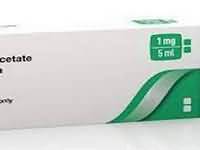CLINICAL USE
Treatment of bleeding oesophageal varices
DOSE IN NORMAL RENAL FUNCTION
2 mg stat dose followed by 1–2 mg every 4–6 hours when required (until bleeding is controlled) for up to 72 hours
PHARMACOKINETICS
DOSE IN RENAL IMPAIRMENT
GFR (mL/MIN)
DOSE IN PATIENTS UNDERGOING RENAL REPLACEMENT THERAPIES
IMPORTANT DRUG INTERACTIONS
Potentially hazardous interactions with other drugs
ADMINISTRATION
Reconstition
With solvent provided
Route
IV
Rate of Administration
–
Comments
Store reconstituted solution in the fridge and discard after 12 hours
OTHER INFORMATION
Maximum plasma levels are reached after 1–2 hours with a duration of action of 4–6 hours Initial response within 25–40 minutes, duration 2–10 hours Some studies have found it can be used to improve renal function in hepatorenal syndrome, in doses of about 3 mg per day for about 11 days May cause hypertension There is a case report of rhabdomyolysis .
